Consumer Trends: What Does the New Normal Look Like?
Find out Wabel’s summary of key consumer insights from the McKinsey Company Perspectives on retail and consumer goods report! A round up of surveys conducted in 45 different countries around the world, based on variables including age and socioeconomic status concluded that mindful and online shopping are trends that are rooted for the future. The caring and homebody economy are important factors for consumers when deciding where to buy, creating a loyalty shock across the sector as they switch up their shopping habits.
Although the impact and evolution of the pandemic is different around the world, consumers are settling into a new normal. We haven’t made it post covid yet, but as everyone transitions from lockdowns into opening up economies, McKinsey & Co found five recurring global themes across consumer habits beginning from mid-March 2020.
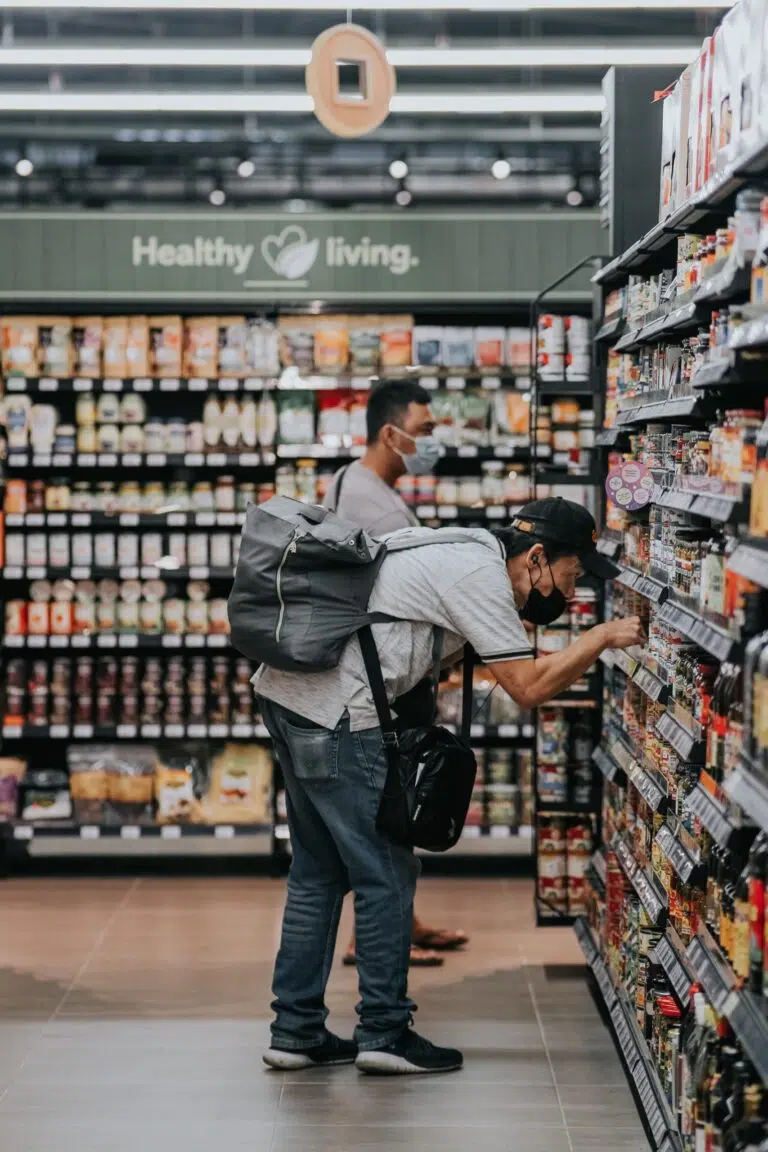
There has been a worldwide shift with consumers focusing on value and essentials, such as groceries and household supplies. Customers are feeling more uncertain about the future of their jobs and the economy of their country. They are being more mindful about their spending and trading down to less expensive products.
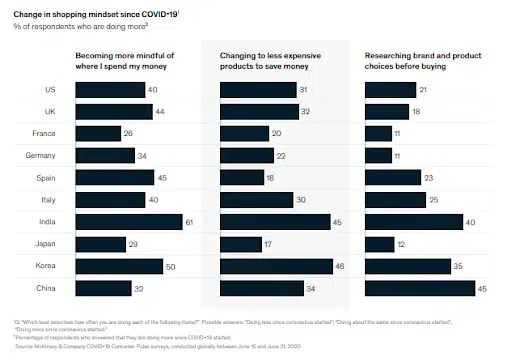
As seen in the chart below, groceries, which are considered an essential category, experienced a clear increase in consumer spending. European consumers in countries such as Germany, Spain or Italy are planning to spend up to 14 percent more than usual on their grocery shopping.
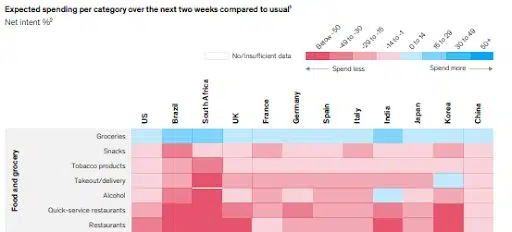
Most categories have experienced more than 10 percent growth in their online customer base during the pandemic. As seen in the chart below, grocery, alcohol as well as household and personal care products spending increased more than 30 percent. Many consumers say they plan to continue shopping online even when brick-and-mortar stores reopen.
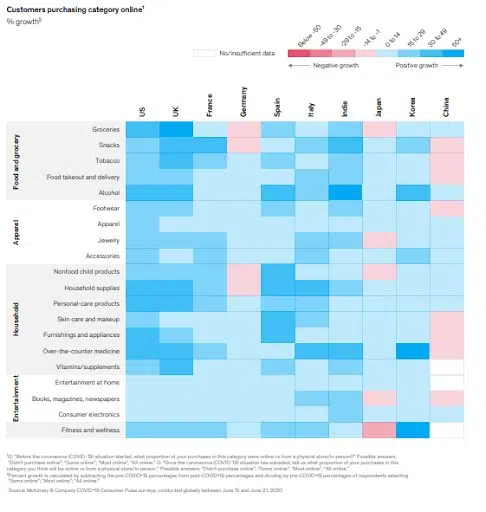
Over 60 percent of global consumers changed their shopping behavior when they couldn’t find their preferred product at their preferred retailer, due to supply-chain disruptions. Value, availability, and quality were important aspects that drove consumers to switch things up. According to surveys, more than half of the consumers said they are likely to stick to their new habits
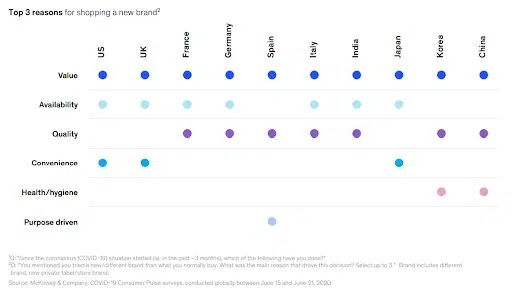
The actions that businesses take during this pandemic are likely to be remembered long after the restrictions have been lifted. When deciding where to shop, consumers are more aware of company values and concern for employees.
They focus on visible safety measures with increased cleaning and physical barriers, as well as healthy and hygienic packaging. For example, beverage companies can add aluminum foil tops on cans. It’s still important for these changes to remain sustainable to align with consumer expectations.
Packaging is a recurring theme for the future. Servair, a leading French airline-catering company, expressed interest in investing in sustainable and innovative packaging in the long term. “Some suppliers had the practical solutions to what we were looking for, and some of them helped us to broaden our perspective. Perhaps we will need them for the long term” said Celia Freixe after the Packaging for Change Summit
More than 70 percent of the McKinsey survey respondents don’t yet feel comfortable going out and resuming their “normal” out-of-home activities. If they do go out, grocery shopping is first on the list, followed by shopping for nonnecessities.
The successions of lockdowns and restrictions have had a profound impact on how people live. Many of the behaviour trends we witnessed were already a part of modern daily life, but have accelerated as consumers were forced to stay home and change their habits.
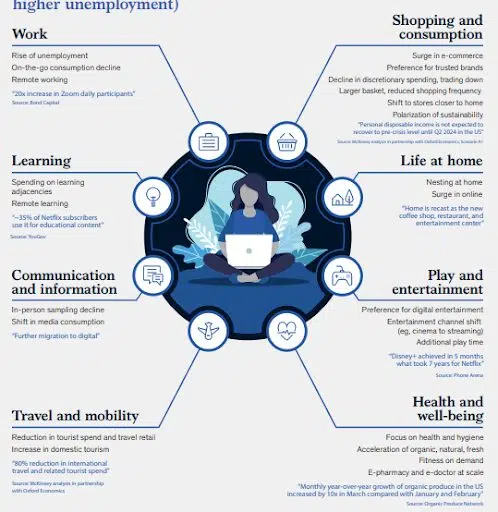
Online delivery increased at a pace that would have taken 10 years, in only 8 weeks since the beginning of the pandemic. Remote working and online video conferencing had 20x more participants than before the pandemic. Wabel Summits responded to the crisis by quickly moving online. Based on surveys sent out after the latest online summits, 92% of suppliers are comfortable meeting new buyers online, and 93% of buyers are comfortable with online meetings. Both buyers and suppliers are happy with the new format, and are interested in continuing their business online even once borders and restrictions are open.
After the latest UP Beauty Wabel Summit, Roxane Gubler from Mettler 1929 in Switzerland said, “Buyers really highlight the online part of sales. I think it’s a good strategy, to push the websites, social media, social shopping, and then once the products are working to implement them in stores.”
ITL Health from Canada, who participated in the Vitamins Supplements Wabel Summit brought up some important positives about online meetings, “Online meetings are easy and much faster. You don’t need to travel around the world to get somewhere, so it saves a lot of time and it’s also more environmentally friendly.”
An important factor that the McKinsey report focuses on is the role that retailers will play in shaping the new normal. A lot of the habits adopted are likely to continue and transition in the long-term. Consumer habits are still being formed. It’s important for brands to reflect on how to innovate and take advantage of this time of change.
– Reinvent the shopping experience: Consumers are looking for easier ways to shop, whether it be online or in-store.
– Stay relevant: Consumers have changed where and how they engage, and brands need to reflect that.
– Value for money: Follow consumers’ budget by thinking about price, private label, branding and merchandising while still maintaining high quality products.
To keep up to date on the latest trends, check the upcoming Online Summits in Grocery, Packaging, Personal Care and Healthcare, Household and Beauty categories!

The European market offers immense potential for success, with its vast and expanding consumer base. Start building valuable connections today by exploring the leading retailers and distributors in Europe, all of whom have a strong demand for products in the food, beverages, household, beauty, and personal care categories.